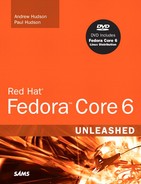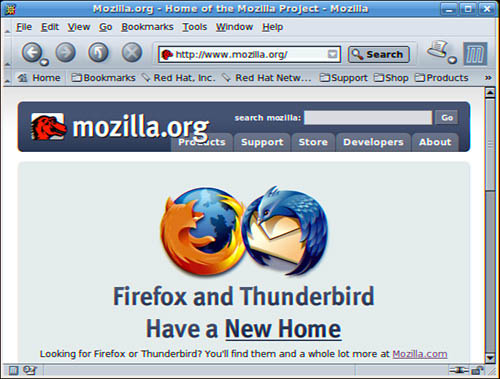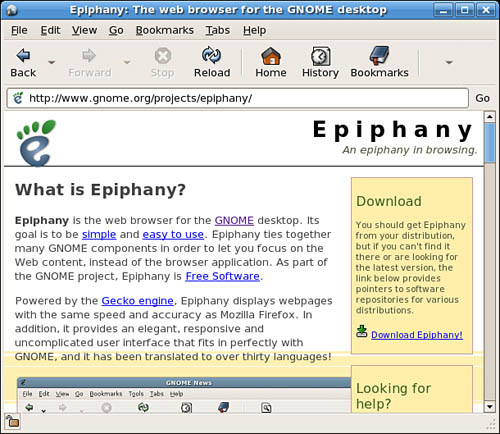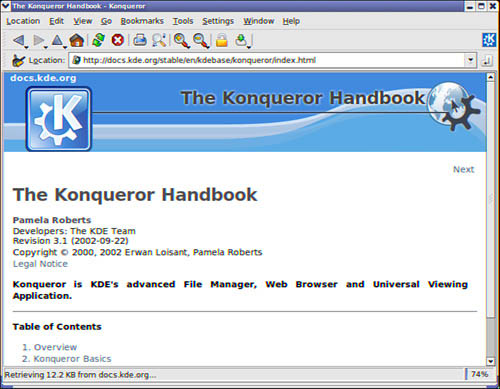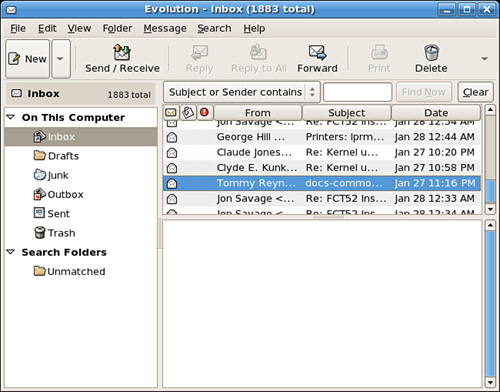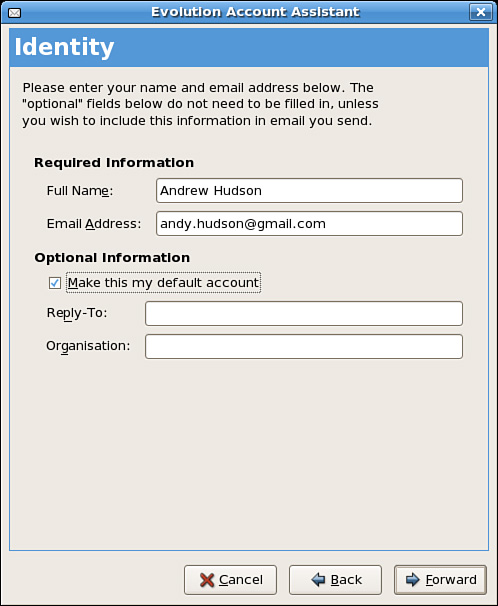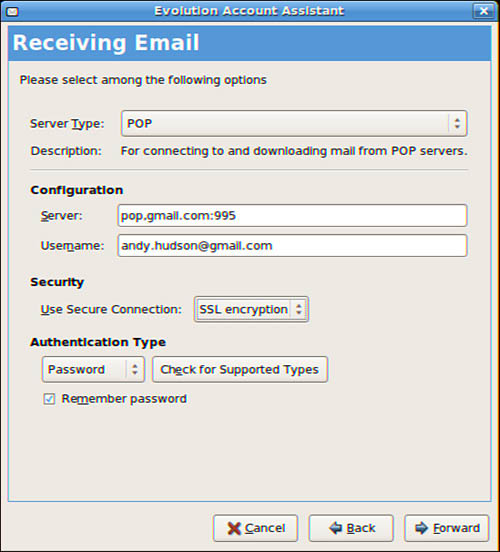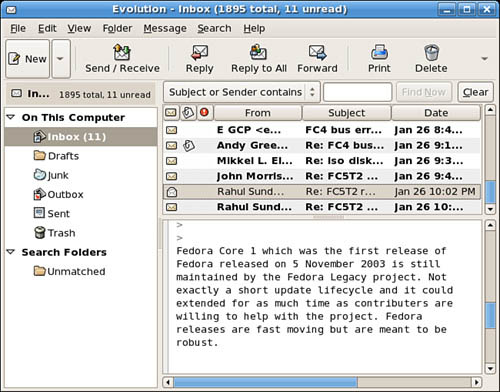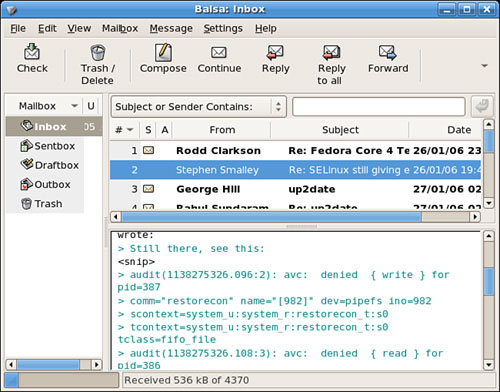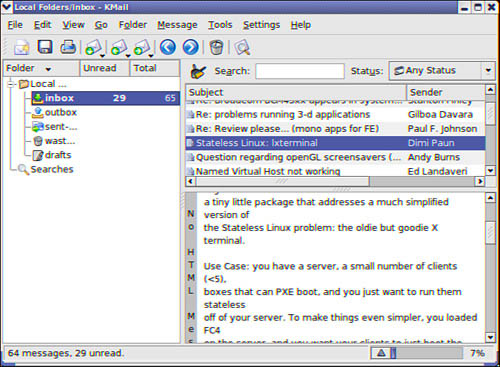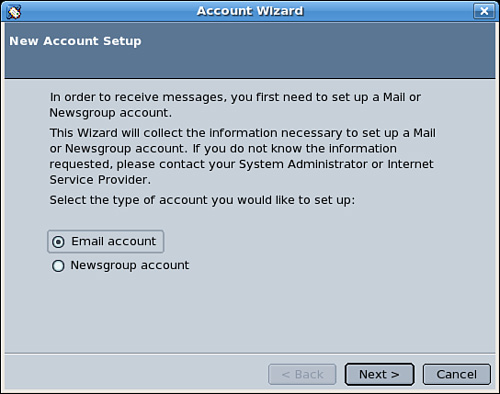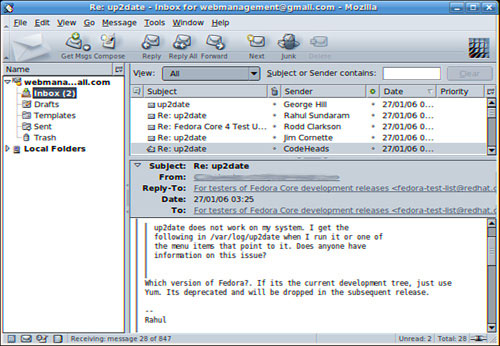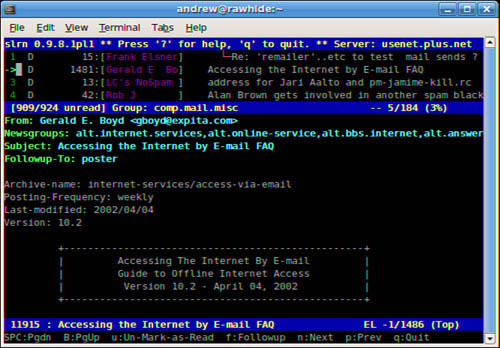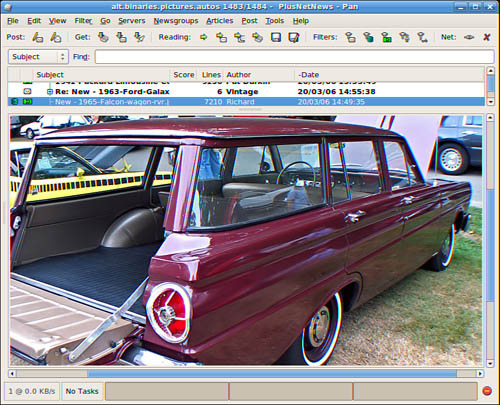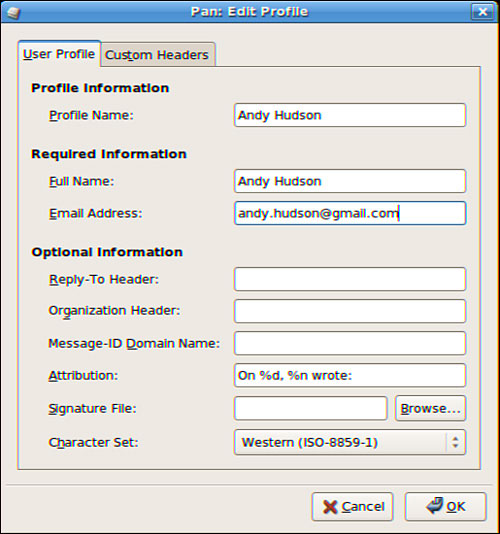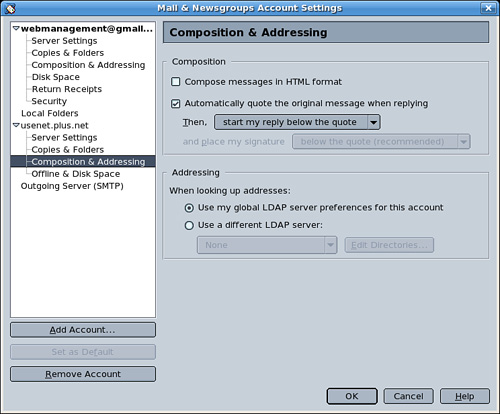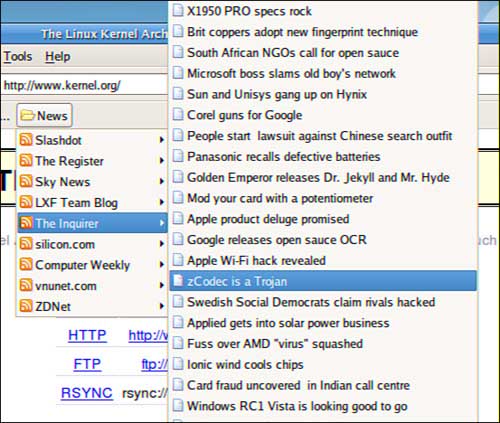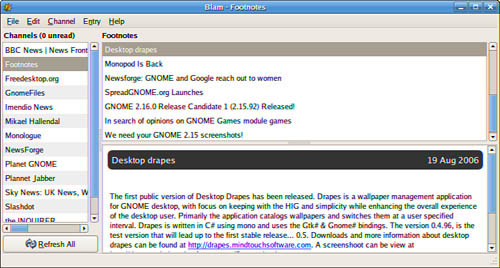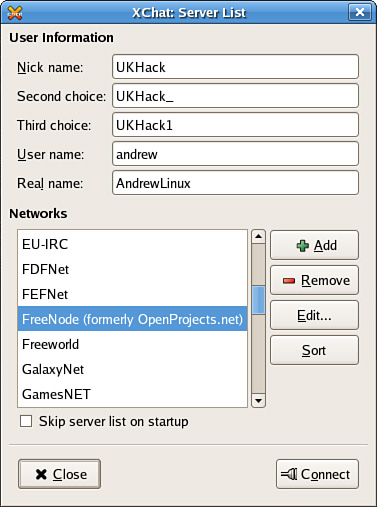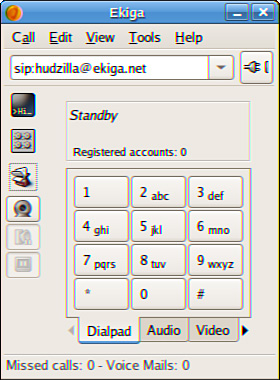IN THIS CHAPTER
The Internet has revolutionized our modern civilization within a very short time. Not long ago it was unheard of to be communicating through the Internet, and computer networks were viewed with some suspicion thanks to various Hollywood blockbusters such as WarGames and Terminator; nowadays you are deemed backwards if you do not have an email account or an instant messenger “nick.” This chapter introduces you to some of the more popular software that you can use to access the Internet, send and receive email, read network news, collaborate with others using an online collaboration tool, and talk in real-time using instant messaging and even videoconferencing. You will find out how to set up each piece of software to access the resources you need.
The Internet has forever changed how we access and share information. The ways in which we view the Internet have also changed and are continually improving to give better and richer experiences. In this section, we look at some of the popular open-source web browsers available for Fedora.
One of the most popular web browsers, and in fact the default web browser in Fedora, is Mozilla Firefox (see Figure 8.1). Built on a solid code base that is derived from the Mozilla Suite, Firefox offers a new lease on life to surfing the Internet. More than 25 million people have downloaded Firefox since its release in late 2004, and it has grabbed significant market share from Internet Explorer.
In Fedora you will find Firefox under the Applications, Internet menu at the top of your screen. An even simpler way to start Firefox is to click the small world icon next to the Actions menu. Either way, you will open Firefox.
Beyond the basic program are a wealth of plug-ins and extensions that can increase the capabilities of Firefox beyond simple web browsing. Plug-ins such as Shockwave Flash and Java are available instantly, as are multimedia codecs for viewing video content, whereas extensions provide useful and sometimes humorous additions to the browsing experience. For example, ForecastFox is an extension that gives you your local weather conditions, and Bandwidth Tester is a tool that calculates your current bandwidth. As Firefox grows, there will be more and more extensions and plug-ins that you can use to enhance your browsing pleasure.
The Mozilla Suite was the first major competition to Microsoft’s Internet Explorer. After the browser wars of the late ’90s, when Netscape was almost ground into the dust by Microsoft, a group of employees at Netscape decided to open source their existing browser and connected applications. What became available was the Mozilla Suite, and it formed the foundation of future Netscape releases. Firefox was born out of Mozilla, and owes its existence to the pioneering work done by the Mozilla Foundation.
The Mozilla Suite is more than just an Internet browser; it encompasses an email and newsreader component, a simple web design component, an IRC client, and an address book. For the moment we will look at the browser component, but the other components are covered later. Bear in mind that if you install Mozilla, you also get the other components of the suite: the mail and newsgroup reader, the address book, and the IRC client. If you do not require all of this, you might be better off with Firefox.
The Mozilla Suite is included by default in Fedora, although it is not listed in the Internet menu. If you drop down to a terminal by right-clicking on the Desktop and selecting New Terminal, you can start Mozilla by typing mozilla. The default theme for Mozilla is fairly retro, harking back to earlier versions of Netscape, but it is easy to change that by clicking the View menu, and then clicking on the Apply Theme entry, and finally selecting Modern. You will need to restart Mozilla for the new theme to be applied.
Epiphany is the browser supplied with the vanilla GNOME desktop (see Figure 8.3). Very basic and built on the same Gecko rendering engine as Firefox and Mozilla before it, Epiphany has advanced in a number of areas to the current version. Some people like Epiphany for its simplicity, whereas others use it because it is just there. If you want the true GNOME experience, you should choose Epiphany.
KDE users have the option to use Konqueror, which is the default browser for KDE (see Figure 8.4). As well as handling file system navigation, Konqueror can also be used to surf the Web. It, too, is based on the Gecko rendering engine as found in Firefox, Mozilla, and Epiphany.
Back in the days of UNIX, there were various text-based email clients such as elm and pine (Pine Is Not Elm). Although they looked basic, they allowed the average user to interact with his email, both for composing and reading correspondence. With the advent of mainstream computing and the realization that people needed friendly GUI interfaces to be productive, came a plethora of email clients, with some of them being cross-platform and compatible among Linux, Windows, and Mac OS X, not to mention UNIX.
Note
The amazing deluge of spam and Internet scams using forged headers has spurred interest in a “better mousetrap.” One such project is AMTP at http://amtp.bw.org/, an enhancement for SMTP. This specification calls for mail servers needing a signed security certificate and using TLS (Transport Layer Security, RFC2246). An AMTP mail server will not relay mail from an “untrusted source”—in other words, a mail server lacking the proper authentication. Although not eradicating spam, AMTP does provide a mechanism to identify the source.
Evolution, a Ximian/Novell product, is the standard email client that comes with Fedora (see Figure 8.5). If you have used Microsoft Outlook, Evolution’s interface will come as no great shock. It really is a drop-in replacement for Outlook and encompasses many of Outlook’s features and benefits, including email, calendaring, contact management, and task management. Here we examine how to get Evolution configured for email access.
You need to have the following information to successfully configure Evolution:
Your email address
Your incoming email server name and type (that is, pop.email.com, POP, and IMAP)
Your username and password for the incoming server
Your outgoing email server name (that is, smtp.email.com)
After you have all the information, you can start Evolution. The first screen you are presented with is the Account Setup Assistance (see Figure 8.6).
The next screen permits you to configure Evolution to use your MTA. You can choose POP, IMAP, the local spools found in /var/mail in either mbox or maildir format, a local MTA, or None if you simply want to use the other features of Evolution. As shown in Figure 8.7, you can also set your password.
You must also choose between SMTP or Sendmail for sending your mail; enter your email address, and choose a time zone (very important for your calendar). Finally, you will see the opening Evolution inbox window in Figure 8.8.
Each icon in the left pane of the main Evolution window opens a different window when selected. Each view has options that can be configured to suit your needs; just click each window’s Tools menu item, for example, to open the Tools screen, shown in Figure 8.9.
Mozilla Thunderbird is the sister program to Firefox. Whereas Firefox is designed to browse the Web, Thunderbird’s specialty is communication. It can handle email, network news (see later in this chapter), and RSS feeds.
Thunderbird is not installed by default with Fedora, so you will have to use either yum or system-config-packages to install it. As with Firefox, there are many plug-ins and extensions to enhance your email and newsreading.
Balsa is an email client designed to work with GNOME. Configuring Balsa is similar to configuring Evolution, although most of the configuration is done from the Preferences menu item, and the basic functionality is similar. Figure 8.10 shows a screenshot of the Balsa interface.
If you are using the KDE Desktop Environment rather than the Fedora default GNOME desktop, you will also have KMail installed. As with Balsa, it will not take users of Outlook Express or Mozilla Mail very long to get used to the KMail interface. Some useful features found in KMail are the choice of mbox or maildir formats, improved filter creation, the ability to sort mail into threads, and the ability to apply filters at the MTA. Figure 8.11 shows the KMail email program. KMail offers IMAP access; extensive filtering; mbox and maildir formats; and the ability to easily integrate MTAs such as Procmail, Spamassassin, and custom processing scripts.
Mozilla is more than a browser: It is an Internet Relay Chat client and a mail and newsgroup reader. The Mail and News Setup Wizard and preferences can be found under the Edit menu item. When you select Mail & Newsgroup Account Setup and then click New Account, the wizard dialog appears, as shown in Figure 8.12.
Configuration via the wizard is easy: Mozilla prompts you for the necessary information. The Mail interface (shown in Figure 8.13) is familiar to many users. If you use Mozilla for web browsing, using it for email is a natural extension. Mozilla Mail is also a good choice for those who do not need all the features offered in the Evolution mail client.
A UNIX utility named mail is included with all UNIX and Linux distributions. Because it has a very Spartan interface, it is not commonly used interactively. However, mail is still an extremely useful program to use in shell scripting because it can take all the information it needs to send mail from the command line. No user interaction is required. mail is also useful for sending quick notes because it starts up quickly and doesn’t require going through menus to send a message.
To begin sending a message in mail, simply type mail at the shell prompt, followed by the email address that you want to send mail to:
$ mail [email protected]
mail then prompts you for the subject of the message. Enter the subject and press Enter. The cursor then moves down to the next blank line. You can now start entering the body of your message. When you finish, press Ctrl+D on a blank line to exit the mail program and send the message. (You might be prompted for Cc:. If you do not want to send carbon copies to anyone, simply press Enter.) The message is handed off to the MTA, and your shell prompt returns. To abandon a message you are currently writing, press Ctrl+C.
If you want to retrieve your email using the mail program, simply type mail at the shell prompt. The system will respond with something similar to the following:
Mail Type ? for help. "/var/mail/andrew": 1 message 1 unread >U 1 [email protected] Sun Mar 20 07:15 18/551 "Birthday" >N 2 [email protected] Sun Mar 20 08:25 18/542 "A large and obnoxious spam message" >N 3 [email protected] Sun Mar 20 09:21 17/524 "Fedora 4 Update" >N 4 [email protected] Sun Mar 20 09:24 17/528 "Issues" &
The & prompt is mail’s way of prompting you for input.
The first column in the list of messages is a flag that indicates the status of the message. For example, U means that the message is unread. N means that the message is new. The rest of the columns are self-explanatory.
To read one of these messages, simply type the message number and press Enter.
For example,
& 4 Message 4 From [email protected] Sun Mar 20 09:24:35 2003 Date: Tue, 23 Sep 2003 09:24:34 -0500 From: [email protected] To: [email protected] Subject: Issues Hey Nick, The new issue looks great! Where did you get the idea for the cover from? Seeya &
If you want to respond to this message, you can type respond and press Enter. You can also simply type r and press Enter. By default, the command is applied to the currently active message, which is indicated in the message list by a > (and will be the last message that you read). If you want to have the command applied to a different message, you can simply specify the message number after the command. For example, typing r 2 will respond to message number 2.
A complete list of commands is available within mail by typing ? at the prompt. Note that you can abbreviate all commands to the shortest abbreviation that is not ambiguous.
As mentioned previously, mail’s most useful application is its use in shell scripting. The complete instruction to create and send a message can be done from the command line. For example, suppose that we have a shell script that generates a report and stores it as a text file. Now we want to email that text file to a user at the end of the script. With mail, we could use a command such as the following:
$ mail [email protected] -s "Report from shell script" < report.txt
The -s specifies a subject line on the command line, and then we use simple shell redirection to use the file report.txt as the body for the message (see Chapter 15, “Automating Tasks”). It is simple, clean, and requires no user interaction to send the message. For other options available on the mail command line, see the man page for mail.
mutt is a relatively new command-line mail client that is rapidly becoming popular with users. The client is called mutt because it is known as “the mongrel of email clients” in that it attempts to combine the best features of several other clients such as elm and pine. Mutt is an extremely feature-rich email client, although it is not as easy to use as pine. It is however, more secure than pine. Figure 8.14 shows the mutt interface.
To check the version and see the compile time options, use mutt -v like this:
$ mutt -v Mutt 1.4.2.1i (2004-02-12) Copyright (C) 1996-2002 Michael R. Elkins and others. Mutt comes with ABSOLUTELY NO WARRANTY; for details type `mutt -vv'. Mutt is free software, and you are welcome to redistribute it under certain conditions; type `mutt -vv' for details. System: Linux 2.6.11.1177_FC4 (i686) [using ncurses 5.4] Compile options: -DOMAIN -DEBUG -HOMESPOOL -USE_SETGID -USE_DOTLOCK -DL_STANDALONE +USE_FCNTL -USE_FLOCK +USE_POP +USE_IMAP +USE_GSS +USE_SSL +USE_SASL +HAVE_REGCOMP -USE_GNU_REGEX +HAVE_COLOR +HAVE_START_COLOR +HAVE_TYPEAHEAD +HAVE_BKGDSET +HAVE_CURS_SET +HAVE_META +HAVE_RESIZETERM +HAVE_PGP -BUFFY_SIZE -EXACT_ADDRESS -SUN_ATTACHMENT +ENABLE_NLS -LOCALES_HACK +HAVE_WC_FUNCS +HAVE_LANGINFO_CODESET +HAVE_LANGINFO_YESEXPR +HAVE_ICONV -ICONV_NONTRANS +HAVE_GETSID +HAVE_GETADDRINFO ISPELL="/usr/bin/ispell" SENDMAIL="/usr/sbin/sendmail" MAILPATH="/var/mail" PKGDATADIR="/usr/share/mutt" SYSCONFDIR="/etc" EXECSHELL="/bin/sh" -MIXMASTER To contact the developers, please mail to <[email protected]>. To report a bug, please use the flea(1) utility.
If you want to change the options (such as any paths) you will need to recompile mutt from the source code.
The latest versions of mutt, as well as news and information about it, are available at http://www.mutt.org/. mutt is proud to be a bug-free program, but its authors believe it might have a few “fleas”—thankfully, these are few.
The systemwide configuration file is kept at /etc/Muttrc, and each user can have his own ~/.muttrc files. mutt configuration is often an evolving process, as each user attempts to configure this feature-rich mail client.
Before you can use mutt, you need to configure a .muttrc file for each user’s home directory. A sample file is found in /usr/share/doc/mutt-*/sample.muttrc; just copy it (or the systemwide file) to .muttrc in the appropriate home directory. There, edit it to reflect how you have your mail system configured and set your preferences; you will find mutt highly customizable, awkward to configure, and simple to use.
Sending and receiving messages using mutt is very easy; the colorful display provides a subset of common commands, and F1 brings up the online help documents.
The mail clients included by Fedora are only a few of those available. Sylpheed-claws (not included) is very popular because it offers spell-checking while typing and is well-suited for use in large network environments in which network overhead and RAM usage are important considerations. You can find other mail clients and applications suitable for use with Fedora by searching http://freshmeat.net/.
The concept of newsgroups revolutionized the way information was exchanged between people across a network. The Usenet network news system created a method for people to electronically communicate with large groups of people with similar interests.
The following sections describe the Usenet network newsgroup format and how newsgroup information is transmitted between hosts. As you will see, many of the concepts of Usenet news are embodied in other forms of collaborative communication.
Usenet newsgroups act as a form of public bulletin board system. Any user can subscribe to individual newsgroups and send (or post) messages (called articles) to the newsgroup so that all the other subscribers of the newsgroup can read them. Some newsgroups include an administrator, who must approve each message before it is posted. These are called moderated newsgroups. Other newsgroups are open, allowing any subscribed member to post a message. When an article is posted to the newsgroup, it is transferred to all the other hosts in the news network.
Usenet newsgroups are divided into a hierarchy to make it easier to find individual newsgroups. The hierarchy levels are based on topics, such as computers, science, recreation, and social issues. Each newsgroup is named as a subset of the higher-level topic. For example, the newsgroup comp relates to all computer topics. The newsgroup comp.laptops relates to laptop computer issues. Often the hierarchy goes several layers deep. For example, the newsgroup comp.databases.oracle.server relates to Oracle server database issues.
Note
The format of newsgroup articles follows the strict guidelines defined in the Internet standards document Request for Comments (RFC) 1036. Each article must contain two distinct parts: header lines and a message body.
The header lines identify information about when and from whom the article was posted. The body of the message should contain only standard ASCII text characters. No binary characters or files should be posted within news articles. To get around this restriction, binary files are converted to text data by using either the standard UNIX uuencode program or the newer Multipurpose Internet Mail Extensions (MIME) protocol. The resulting text file is then posted to the newsgroup. Newsgroup readers can then decode the posted text file back into its original binary form.
A collection of articles posted in response to a common topic is called a thread. A thread can contain many articles as users post messages in response to other posted messages. Some newsreader programs allow the user to track articles based on the threads they belong to. This helps simplify the organization of articles in the newsgroup.
Tip
The free news server news.gmane.org makes the Red Hat and Fedora mail lists available via newsgroups. The beta list is available as gmane.linux.redhat.rhl.beta. It is a handy way to read threaded discussions and easier than using the Fedora mail list archives.
The protocol used to transfer newsgroup articles from one host to another is Network News Transfer Protocol (NNTP), defined in RFC 977. (You can search RFCs at ftp://metalab.unc.edu/pub/docs/rfc/; look at the file rfc-index.txt.) NNTP was designed as a simple client/server protocol that enables two hosts to exchange newsgroup articles in an efficient manner.
Whether or not your Fedora server is set up as a news server, you can use a newsreader program to read newsgroup articles. The newsreader programs just require a connection to a news server. It does not matter whether the news server is on the same machine or is a remote news server on the other side of the world.
Several programs are available for UNIX systems to connect to news servers to read and post articles in newsgroups. The following sections describe the newsreaders that are available with the Fedora distribution.
The slrn program is a text-based newsreader program included with the Fedora distribution. It uses the ncurses package to paint text-based windows on the terminal screen. slrn can be used to both read and post articles to newsgroups on a configured news server. If you want to use the same newsreader on different platforms, slrn runs on Linux, Mac, OS2, BeOS, Windows, and VMX. It now provides true offline reading capabilities.
The slrn program is included in the slrn RPM package; you install it by using the yum or rpm command. After you have installed slrn, you need to create a local configuration file. Begin by setting an environmental variable:
$ export NNTSERVER=news.andbhudson.co.uk
Of course, you will use your own news servers’ domain name.
Then create your local configuration file with
$ slrn -f .jnewsrc -- create
and launch slrn. The configuration file, located at /etc/slrn.rc, is a well-commented file that is easy to modify and customize.
When slrn starts, it displays a list of the groups that are available on the news server. You select the group you want to read articles from, and then select the individual articles. Figure 8.15 shows a slrn screen example.
Pan is a graphical newsreader client that works with GNOME and is the default newsreader for Fedora. If you have the GNOME libraries installed (and they usually are installed by default), you can also use Pan with the K Desktop Environment (KDE). Pan has the capability to download and display all the newsgroups and display posted news articles. You can launch it by using the GNOME or KDE desktop panel or from the command line of an X terminal window with the command pan &. Pan supports combining multipart messages and the yenc encoding/decoding protocol. Figure 8.16 shows a sample Pan display. Unlike the slrn program, Pan does not require a systemwide default or user-defined NNTPSERVER environment variable to define the news server address, but you do need to configure Pan.
The first time you run Pan, a configuration wizard appears and prompts you for your name, the SMTP server name, the NNTP server name, and the name you want to use to identify the connection (in the example shown in Figure 8.17, we use Cavtel). After the wizard is finished, you are prompted to download a list of the newsgroups the server provides; this might take a while. If you need to change the news server or add an additional server, you can access the Preferences item under the Edit menu to bring up the list of servers. Then, you highlight the appropriate one and click Edit to change it or just click the New button to add a new news server.
The KNode program is part of the kdenetwork RPM package—the KDE network package included in Fedora. KNode is usually installed by default if you select the KDE windows manager option in the Fedora installation.
The KNode program is an excellent graphical program (similar to MS Outlook Express) that allows you to connect to news servers (either a local or remote server) and select newsgroups where you can read and post articles. Before you can begin, though, you must configure the address of your news server in KNode. You do this from the Settings menu item on the main KNode window; select the Configure KNode item, and the KNode configuration window appears. Under the Accounts item, select the News item. A list of configured news servers appears in the window. To add a new news server, click the New button. Figure 8.18 shows the KNode New Account window, where you can enter the new news server information.
The Mozilla web browser supports graphical Usenet newsreading as well as web browsing. Having numerous newsreading clients installed on a Fedora system offers users a wealth of choice and opportunities for developing favorites. In some cases, however, it can complicate the administrator’s task of tracking and fixing client security liabilities. Using Mozilla can help simplify this task by offering an all-in-one client that provides web browsing, email, file transfer, and newsreading capabilities. For these reasons, you might choose to use Mozilla as a browser, email client, and news client. Mozilla is the default browser for Fedora.
To begin reading news with Mozilla, you launch Mozilla and select Window, Mail and Newsgroups; the window shown in Figure 8.19 appears. The menu Edit, Mail & Newsgroups Account Settings is where you configure Mozilla for your news and mail server settings. Many people prefer to use Mozilla for all their web browsing, mail, news, and IRC.
To add accounts, under Edit, Mail & Newsgroups Account Settings, click the Add Account button and select either a mail or news account to add. The Account Settings dialog is shown in Figure 8.20.
When you finish entering this information, click OK, and you arrive at the newsreader window. Click the news server name in the left pane and then select Subscribe to Newsgroups in the right pane to begin downloading a list of newsgroups from your news server. At any time, you can update the list of newsgroups by clicking the Refresh button in that window.
Along with Firefox, the Thunderbird mail and news client is a direct descendant of the Mozilla suite. Designed to be lightweight and with a clean interface, Thunderbird does many of the things that the Mozilla news client can do but is a separate application from Firefox.
To add a new account to Thunderbird, click Tools, Account Settings and select Add Account. Select the news account and follow the prompts giving Thunderbird all the information it needs.
When you have finished providing Thunderbird with all the relevant information, click OK, and you arrive at Thunderbird’s default view. Along the left pane you will see the new news server account. Click it and then select Manage Newsgroup Subscriptions.
RSS is one of the protocols of Web 2.0, the next generation of Internet content. Although RSS has been in use for a couple of years now, it has only recently started to really take off thanks to adoption across a large number of websites and portals.
The key advantage of RSS is that you can quickly read news from your specific choice of websites at a time that suits you. Some services offer just the headline of the article, whilst others offer the full article for you to view. RSS feeds can be accessed in various ways, even through your web browser!
Firefox implements RSS feeds as what it calls Live Bookmarks (shown in Figure 8.21), which is essentially a bookmark with sub-bookmarks, each linking to a new page from your chosen website. I like to have several news sites grouped together under a folder on my toolbar called news, allowing me to quickly browse through my collection of sites and pick out articles that really interest me.
One of a new breed of applications developed using the mono framework, Blam is an extremely easy to use RSS newsreader. It is configured by default to subscribe to a handful of RSS feeds, and it is very easy to add your own in. Press Ctrl-N to open the new channel dialog, and make sure you enter the RSS feed you want to subscribe to into the empty field. Blam will then go and retrieve the latest headlines from your chosen site and display them for you, as shown in Figure 8.22
Although Usenet is a useful interactive and collaboration tool, in some cases a web-based tool is better suited to your needs. TWiki (http://TWiki.org/) is a web-based interactive collaboration tool that can also be used as a bulletin board, knowledge base, bug tracker, and software archive.
Tip
You can examine the TWiki Success Stories on the company’s home page for any encouragement you need to explore TWiki. You can also explore this Linux-related public TWiki site (http://TWiki.org/cgi-bin/view/Wikilearn/WebHome/).
TWiki is not available from Fedora, and you must download it from the TWiki website after completing a brief registration. You then receive email instructions explaining how to download a .zip file from the site. (You use unzip to extract the files.) The program is licensed under the GPL.
You might want to first read the installation instructions located at http://TWiki.org/cgi-bin/view/TWiki/TWikiDocumentation. The documentation has been improved over the past year and now includes directions for installing TWiki as the non-root user. Many details are provided on file ownership and file permissions. There is also an automatic installer—the O’Wiki Installer—referenced at http://TWiki.org/cgi-bin/view/Codev/TWikiUnixInstaller. This might be a good approach to use if you are skilled at Apache configuration, but the install script does not set the appropriate file ownership and permissions for Fedora as mentioned later.
Here is a short list of advice for moving smoothly through the installation process on a Fedora system (this list assumes that you are performing an installation as the root user and are reading the TWiki installation instructions from the TWiki website):
You need to create the directory
/home/httpd/twiki; unzip TWiki into this directory.The installation instructions mention the file
/etc/httpd/httpd.conf. For Fedora, this file is found at/etc/httpd/conf/httpd.conf. You simply copy and paste the entries shown in the example supplied by the downloaded instructions.The path to Perl for Fedora is
/usr/bin/perl.Fedora runs CGI scripts as the user
apache, not the usernobody, as assumed in the default TWiki installation. You can browse to http://localhost/twiki/bin/testenv and read the warnings that are displayed onscreen. This is a special script run on your local machine to help you diagnose any problems with your installation. The messages should be specific to your installation, and any warning should be accompanied by a suggestion about how to fix the problem.
The TWiki installation directions suggest setting permissions and changing ownership. For Fedora, the permissions are set correctly, but the ownerships are wrong. To change the ownerships, implement the following steps (after each step, you should reload the http://localhost/twiki/bin/testenv page to check your progress):
Change the group ownership of everything to
apache, but change the group ownership of/httpd/twiki/templatesback toroot:# chgrp -r apache /home/httpd # chgrp -r root /home/httpd/twiki/templates
Remember to edit
/home/httpd/twiki/lib/TWiki.cfgto reflect your own domain name instead of http://your.domain.com.Change the ownership of the RCS repository files to the user
apache:# cd /home/httpd/twiki/data # perl -pi -e 's/nobody:/apache:/' */*,v
After you complete the installation, you should have a “virgin” TWiki installation that you can view at http://localhost/twiki/bin/view. As with any application, you need to further configure this file so that it suits your needs. The TWiki documentation explains the many configuration options and processes available to you. This documentation is included in the TWiki installation you just completed.
As documented in RFC 2812 and RFC 2813, the IRC protocol is used for text conferencing. Like mail and news, IRC uses a client/server model. Although it is rare for an individual to establish an IRC server, it can be done. Most people use public IRC servers and access them with IRC clients.
Fedora provides a number of graphical IRC clients, including XChat, licq-kde, and Mozilla-chat, but there is no default chat client for Fedora. Fedora Linux also provides the console clients epic and licq for those who eschew X. If you don’t already have a favorite, you should try them all.
Caution
You should never use an IRC client while you are the root user. It is better to create a special user just for IRC because of potential security problems. To use XChat in this manner, you open a terminal window, use su to change to your IRC user, and start the xchat client.
XChat is a popular IRC client, and it is the client that is used in this chapter’s example. The HTML documents for XChat are available in /usr/share/docs/xchat. It is a good idea to read them before you begin because they include an introduction to and cover some of the basics of IRC. To launch the XChat client, select the IRC Client item from the Internet menu found under the Extras menu, or you can launch it from the command line, like this:
$ xchat &
The XChat application allows you to assign yourself up to three nicknames. You can also specify your real name and your username. Because many people choose not to use their real names in IRC chat, you are free to enter any names you desire in any of the spaces provided. You can select multiple nicknames; you might be banned from an IRC channel under one name, and you could then rejoin using another. If this seems slightly juvenile to you, you are beginning to get an idea of the type of behavior on many IRC channels.
When you open the main XChat screen, a list of IRC servers appears, as shown in Figure 8.23. After you choose a server by double-clicking it, you can view a list of channels available on that server by choosing Window, List Window. The XChat Channel List window appears. In that window, you can choose to join channels featuring topics that interest you. To join a channel, you double-click it.
After you select a channel, you can join in the conversation, which appears as onscreen text. The messages scroll down the screen as new messages appear.
Tip
You can establish your own IRC server even though Fedora does not provide one. Setting up a server is not a task for anyone who is not well versed in Linux or IRC.
A popular server is IRCd, which you can obtain from ftp://ftp.irc.org/irc/server/. Before you download IRCd, you should look at the README file to determine what files you need to download and read the information at http://www.irchelp.org/irchelp/ircd/.
IM has been popularized by America Online (AOL) as a way for AOL users to chat directly with each other rather than speak in chat rooms. As long as the IM clients for everyone involved in the conversation are running, they alert you to any incoming messages. The clients also announce to the server that you are active and listening for messages, so your friends can be made aware via buddy lists that you are available to chat with them.
You can use IM in place of IRC for interoffice collaboration. Fedora provides the GAIM IM client, for your use. To use it, you need to be communicating with a group of “buddies” who are active IM users as well.
GAIM is a GNOME (GTK-based) IM client that supports a wide range of protocols such as TOC, AIN/ICQ, Yahoo!, IRC, Jabber, Napster, Zephyr, and Gadu-Gadu. GAIM is a feature-rich message client, and it has support for plug-ins that extend the functionality of the application.
Note
GAIM supports Jabber, an open XML-based IM protocol that can be used to set up a corporate IM server. Jabber is not supplied with Fedora, but you can obtain additional information about it from the Jabber home page at http://www.jabber.com/. You can obtain the Jabber server, Jabberd, from http://jabberd.jabberstudio.org/. If you want to use GAIM locally for collaboration, Jabber would be an excellent choice for a private local server.
Ekiga is an Internet videoconferencing application that provides two-way voice and pictures over the Internet by using the H.323 protocol for IP telephony (also known as Voice over IP [VoIP]). It is an application similar to Microsoft NetMeeting and is provided with Fedora as the default videoconferencing client.
Before you can take full advantage of the phone and videoconferencing capabilities of Ekiga, you must configure a full-duplex–capable sound card and video device (see Chapter 10, “Multimedia Applications”) as well as a camera.
Ekiga is found in the Internet menu as Videoconferencing; you click on the icon to launch it. When you start the Ekiga application for the first time, a configuration wizard (called a “druid”) runs and you are greeted by the first of four configuration screens. You simply enter your name, email address, and location and select your connection type. The settings for your audio and video devices are automatically detected; you can view them by selecting the Preferences item from the Edit menu. Figure 8.24 shows Ekiga in action, ready to dial another user.
When you have Ekiga running, you must register (from within Ekiga) with the server at http://ekigz.net/ to enable conferencing; Ekiga does this automatically for you if you told it to do so during the initial configuration.
You can find an informative FAQ at the Ekiga home page at http://www.Ekiga.org/ that you should read in full before using Ekiga. Also, an excellent article about VoIP is at http://freshmeat.net/articles/view/430/.
Note
If you frequently use VoIP applications such as Ekiga, you will tire of repetitively typing in long IP addresses to make connections. To avoid this hassle, you can use a “gatekeeper”—similar in purpose to a DNS server—to translate names into IP addresses. OpenH323 Gatekeeper is one such popular gatekeeper application. It is not provided with Fedora, but you can obtain it from http://www.gnugk.org/.
http://www.ximian.com/—The home of Ximian Evolution, the standard email client for Fedora.
http://www.mozilla.org/—The home page for Mozilla Firefox, Thunderbird, and the Mozilla Suite.
http://www.spreadfirefox.com/—The Firefox advocacy home page is useful for converting those Internet Explorer types.
